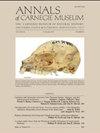岩石水螅,Procavia capensis (Pallas, 1766)(哺乳纲,非洲兽目,水螅科)的颅基轴:额骨的新结构
IF 0.9
4区 地球科学
Q4 PALEONTOLOGY
引用次数: 2
摘要
颅基轴的组成已在许多现存和灭绝的哺乳动物的比较文献中报道。主要成分是不成对的软骨内骨:筛骨、蝶前骨、基底骨和基枕骨。在它们的腹侧有几个真皮成分:包括广泛存在的未配对的腭骨,以及分布更有限的三块骨,成对的腭骨,成对的翼状骨和未配对的副骨。在这里,我们描述了在岩石hyrax, Procavia capensis的颅基轴背侧的新皮肤结构。这个分类群有一对额骨的中间突起,在中线相交,并在蝶前骨与筛骨的结合处覆盖着它;我们称之为额叶的蝶前突。蝶前突的腹侧是第二个较小的突,离中线并呈现与蝶前突上的凸部接触的小面;我们称之为额叶的蝶前突面。占据这两个结构之间缺口的是筛神经。我们对哺乳动物部、卡内基自然历史博物馆和文献中分类多样的藏品进行了取样。我们在偶蹄动物Neotragus和各种platyrrhine和catarrhine灵长类动物中发现了类似于P. capensis额叶前突的额叶间接触的其他实例。然而,我们没有在新龙和灵长类动物中发现蝶前突,因此,到目前为止,这是capensis所独有的。此外,我们报告了新生儿P. capensis蝶前腹面中线缝合线的存在,据我们所知,这也是这种哺乳动物所特有的。本文章由计算机程序翻译,如有差异,请以英文原文为准。
The Basicranial Axis in the Rock Hyrax, Procavia capensis (Pallas, 1766) (Mammalia, Afrotheria, Hyracoidea): Novel Structure of the Frontal Bone
ABSTRACT The composition of the basicranial axis has been reported in the comparative literature in numerous extant and extinct mammals. The primary components are unpaired endochondral bones: the ethmoid, presphenoid, basisphenoid, and basioccipital. Ventral to these are several dermal elements: included are the unpaired vomer, which is widely present, and three bones with more limited distributions, the paired palatines, the paired pterygoids, and the unpaired parasphenoid. Here, we describe novel dermal structures on the dorsal aspect of the basicranial axis in the rock hyrax, Procavia capensis. This taxon has a medial process of the paired frontal bones that meets on the midline and overlies the presphenoid at its juncture with the ethmoid; we term this the presphenoid process of the frontal. Ventral to the presphenoid process is a second smaller process that is off the midline and presents a facet contacting a boss on the presphenoid; we term this the presphenoid facet of the frontal. Occupying the notch between these two structures is the ethmoidal nerve. We sampled the taxonomically diverse collections of the Section of Mammals, Carnegie Museum of Natural History, and the literature. We found additional instances of interfrontal contact dorsal to the ethmoid and presphenoid in the artiodactyl Neotragus and in various platyrrhine and catarrhine primates resembling the presphenoid process of the frontal of P. capensis. However, we did not find a presphenoid facet of the frontal in Neotragus and the primates, which, therefore, thus far is unique to P. capensis. Additionally, we report the presence of a midline suture on the ventral surface of the presphenoid of neonatal P. capensis, which, to our knowledge, is also unique to this mammal.
求助全文
通过发布文献求助,成功后即可免费获取论文全文。
去求助
来源期刊

Annals of Carnegie Museum
综合性期刊-动物学
CiteScore
2.50
自引率
18.20%
发文量
4
审稿时长
>12 weeks
期刊介绍:
Annals of Carnegie Museum is a quarterly journal that publishes peer-reviewed short and medium-length original scientific contributions in organismal biology, earth sciences, and anthropology, in 40 by 52.5 pica format (168 by 220 mm or 6-5/8 by 8-5/8 inches). Subject matter must be relevant to Carnegie Museum of Natural History scientific sections or Powdermill Nature Reserve (PNR), preferably with connection to the Carnegie collection and/or personnel. Carnegie Museum staff and research associates receive publication priority, but others are encouraged to submit papers, especially those manuscripts explicitly based on the Carnegie collection.
 求助内容:
求助内容: 应助结果提醒方式:
应助结果提醒方式:


